

What responsibility do museums have for shaping the public’s relationship with facts? In March I had a conversation with an insightful colleague, Amy Boyle, an educator at the Guggenheim Museum.

Amy suggested that open-ended interpretation might be problematic in a climate in which political discourse disregards facts, and candidates and supporters make up their own truths. I’m not sure I’ve captured the challenges and opportunities offered by this idea, but I am convinced that museums have a role to play in helping people better understand facts and weigh opinions accordingly. Museum educators have long struggled with the tension between teaching facts and curatorial analyses, and opening the door to personal interpretations and meaning-making.
Do we lecture, or do we pose questions and follow the visitors’ lead? During this election season, the tension between sharing information and encouraging individuals to create their own interpretations has taken on new importance. What we know about mobile experiences in Museums after 6 years of research – Frankly Green + Webb – Medium. What we know about mobile experiences in Museums after 6 years of research As part of Frankly, Green + Webb, I’ve carried out research and evaluation on mobile experiences for over 20 cultural organisations.

Area Dad Needs More Time With Museum Plaque. NEW YORK—Leaning in close to the paragraph of text as his family continued on to the museum’s other exhibits, area dad and Frick Collection visitor Phillip Schermeier, 58, reportedly needed more time with the plaque beside Rembrandt’s 1626 painting Palamedes In Front Of Agamemnon Thursday.
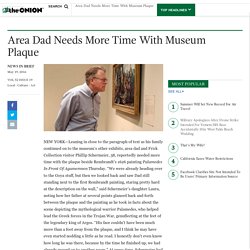
Museums: Educational or Entertaining? Results from Our First Twitter Poll - Museum Hack. We asked our followers… The results are interesting.

As renegade tour guides, many people view our tours as purely entertainment. But they’re not. Our tours take an entertainment-first approach — with a focus on passionate storytelling as a doorway into successfully engaging museum audiences and providing unforgettable educational experiences. The Interpretive Value of a Chair: A Personal Reflection. Written by Susan Spero “For the understanding of a picture, a chair is needed.
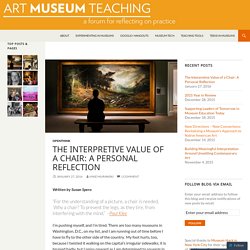
Why a chair? To prevent the legs, as they tire, from interfering with the mind.” Public-Camera-Stand. Museum Hack Featured in Study: What Makes An Engaging Art Museum Experience? - Museum Hack. This past summer, Caroline Perkins was on a mission: to comparatively study art museum adult education programs.
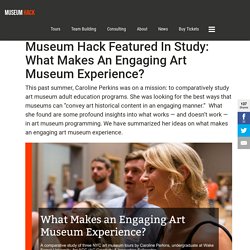
She was looking for the best ways that museums can “convey art historical content in an engaging manner.” What she found are some profound insights into what works — and doesn’t work — in art museum programming. We have summarized her ideas on what makes an engaging art museum experience. Funded by an ACC-IAC Creativity & Innovation Fellowship, Caroline shadowed our Museum Hack renegade tour guides during our Metropolitan Museum of Art Unhighlights tours. She also shadowed the Museum of Modern Art’s Gallery Sessions and the Metropolitan Museum of Art’s General Highlights tours.
Audience Caroline shadowed three different art museum tours throughout her study. Researchers Observe Effects of Art on the Brain. Museum Hack Featured in Study: What Makes An Engaging Art Museum Experience? - Museum Hack. Happy Staffs Mean Happy Audiences. Any Questions? at the Oakland Museum. Last week, I visited the Oakland Museum, whose work I've heard about since I was a graduate student.
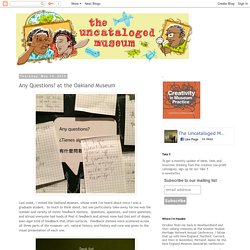
So much to think about, but one particularly take-away for me was the number and variety of visitor feedback stations. Questions, questions, and more questions, and almost everyone had loads of Post-it feedback and almost none had that sort of dopey, teen-ager kind of feedback that often surfaces. Feedback stations were scattered across all three parts of the museum--art, natural history, and history and care was given to the visual presentation of each one. A Day Made Of Glass 1 & 2. The Museum Visitor That Didn’t Exist In 1979 - Museum Hack. Not so long ago, the idea of calling your friend from another country was an absurd idea.
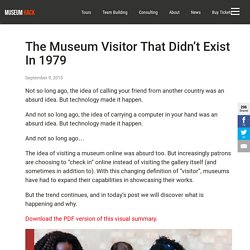
But technology made it happen. And not so long ago, the idea of carrying a computer in your hand was an absurd idea. But technology made it happen. The Most Reliable Way To Increase Visitor Satisfaction To Cultural Organizations (Fast Fact Video) It’s probably not what you think.

It isn’t a brand new wing or fancy new exhibit. Today’s KYOB Fast Facts video explains why providing a certain kind of interaction with frontline staff may well be a visitor-serving organization’s most impactful and reliable investment. The Brave New Museum Sputters Into Life. With so many visitors—particularly the young—obsessively attached to digital devices as instruments of learning and sharing, even the most traditional art museum officials can no longer deny the imperative for technological interventions in what used to be a relatively unmediated relationship between viewer and object.
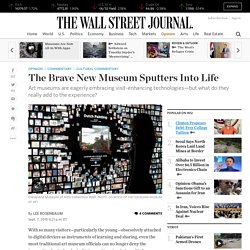
First there were audio guides and websites. Now art museums are embracing everything from apps to robots to interactive pens, hoping to discern how best to enhance the gallery experience for savvy digerati, without ruining it for diehard technophobes. Having recently explored the digital prestidigitations of several pioneering art museums, I have arrived at one firm conclusion: I have seen the future and we’re not there yet. The technological transformation of the art-museum experience is still an experiment in which visitors play the role of guinea pigs. 15 Hilariously Terrible Reviews of Wonderful Museums. It’s impossible to please everyone. Even the finest institutions struggle to make every guest happy—just look at the reviews complaining of long lines, large crowds, and curt security guards on sites like Yelp and TripAdvisor. But the toughest customers to leave reviews seem to have missed the point of the places they've visited entirely.
The Confused Thinking Behind the Kimono Protests at the Boston Museum of Fine Arts. One Japanese man counterprotested the Kimono Wednesday protests to say he is not offended and even encouraged others to join him at future counterprotests. (via japaneseamericaninboston.blogspot.com) The Boston Museum of Fine Arts recently cancelled an event they had called “Kimono Wednesdays,” that, according to the museum, sought to engage people by arranging enhanced encounters with works of art. The function was organized around the display of Claude Monet’s “La Japonaise” (1876) a painting of the artist’s wife, surrounded by fans, wearing a blond wig and a bright red kimono. When the program began visitors were given the opportunity to put on a kimono similar to the one depicted in the painting, and were encouraged to pose for photographs and share those images on social media using the tag “#mfaBoston!”
PyrexSeminarDescripFNL. Testing Notes. Museums Seek Greater Control of Docents. Kat Braz, a graphic designer from West Lafayette, Ind., was visiting the Iolani Palace in Honolulu this past December when she said a guide scolded her for straying from the group. The docent, an older man in a Hawaiian shirt, insinuated that certain people on the tour were fat, she said, and mocked them for not knowing obscure historical trivia. Exquisite Light Boxes Made With Melted Gummy Bears Look Like Stained Glass. These colorful works by Spanish architects Marta Alonso Yebra and Imanol Calderón Elósegui will fool you. At first glance, they might look like stained glass, but they’re actually melted gummy bears. The decorative wall hangings are called “light boxes,” and they delight us with their gorgeous hues and exquisite marbling.
Plus, Yebra and Elósegui’s handiwork has a faint fruity smell to it. Yerba first developed the unusual technique as an art student. The Value of Museum Selfies. I thought the culture wars were over. Applause for the Education Mission of Museums Next week is Museum Advocacy Day (February 24-25). It is a time to publicly acknowledge the vital role of museums, to salute the people who contribute their life to make them meaningful ... and, to thank them for their commitment to educating our young.
Twenty years ago The American Association of Museums published a report on the future of American museums including one chapter titled "A New Imperative for Learning," which admonished that "museums have yet to realize their full potential as educational institutions. " NMC Museum Horizon Report 2015. 12 Ways Successful People Handle Toxic People. The Teacher Who Believes Math Equals Love : NPR Ed.
What makes a great teacher great? » Make Your Writing Clearer: 6 Tips for Re-wording Sentences. 1-4-article-hunter-gatherer-social-existence.pdf. Learn to be a Glassblower. TMR Content Archives. An Honest Letter from Your I.T. Department. Csikszentmihalyi_Intrinisic%20Motivation.pdf. Simon Sinek: How great leaders inspire action. #1 ) The Lone Nut + The First Follower = A Movement ! Hans Ulrich Obrist: the art of curation.